you are here [x]: Scarlet Star Studios > the Scarlet Letters > behind the scenes: Misha Klein and Stage 13
<< before
lsgl: evolving act 2 scene 4
after >>
working on "the whisperer in darkness"
May 11, 2009
behind the scenes: Misha Klein and Stage 13
by sven at 7:00 am
Don't forget the big stopmo event this Wednesday!
An ASIFA Night of Clowns & Owls
With Misha Klein and Dan Ackerman
Wed. May 13th,
7pm-9pm @ Studio 13
13 NW 13th Ave.
Admission is FREE for card-carrying members
$3 for non-members
To whet your appetite, here's a look behind the scenes…
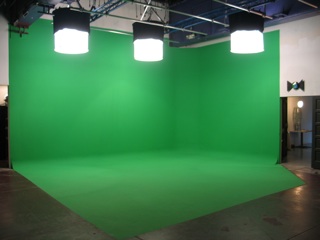
In February -- on Friday the 13th -- I had the pleasure of attending the launch party for Ackerman Films' "Stage 13" space. Wow! In addition to an editing bay, and several work areas, this magnificent 26'x22'x13' high Corner Green Screen Cyclorama is available for rental. If you're looking for a space in which to work on your film, check out the Ackerman Films website for details.
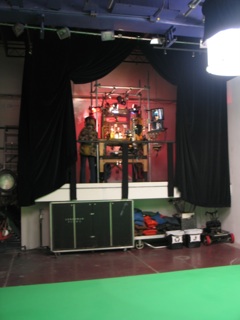
Of course, for me the highlight of the party was getting to see Misha's workspace. He was very gracious answering questions for party attendees and showing clips from his film.
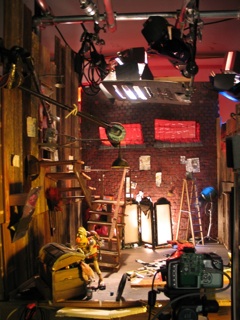
Misha's project has taken 8 years to complete, putting in about a month per year between paying gigs. Work started in L.A.; when he moved up to Portland, everything had to get packed into boxes for shipping. He says Stage 13 has been a great environment to work in.
For the set, he got friends to pitch-in building props. Music is going to be recorded by a trio in San Francisco. [Never underestimate the value of a good soundtrack!]
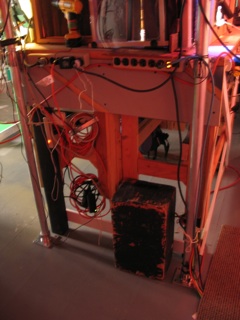
As is typical in stopmo productions, the set is built atop wooden tables that make it comfortable to animate from a standing position. For Misha's project, however, the wooden tables are also firmly attached to a tubular metal cage (which supports the lights) -- and this cage is bolted to the floor.
The camera is attached to the set itself. Consequently, even if you managed to move the cage, the stage and lights and camera are all going to move together -- the shot doesn't get ruined.
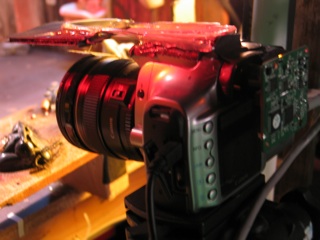
For his camera, Misha's using a Canon EOS Rebel. He shoots using RAW image format. For some shots (e.g. "drunk cam"), having the extra pixels means it's been possible to do virtual camera moves.
In general though, most of the camera moves are done in the real world. At the party, Misha boasted that the last shot he'd filmed used seven axes of motion. Dolly, truck, rack, rotary…
Just below the floor of the set is an XY table. There's another threaded rod to move the camera up and down… And the camera is attached to a 410 Manfrotto geared mount. [I don't understand the set-up well enough to count up all seven axes myself.]
On some shots, the Manfrotto was attached to a heavy base and moved around the set by hand -- creating a looser "hand-held" look.
In my own work, I've tended to lock down the camera. It's been a real revelation to see how much camera movement Misha goes for. In part it means you can keep a tight framing on a character while they act… But Misha also points out that when the camera's locked down, you lose a lot of the 3D nature of the world you've created. Good thought!
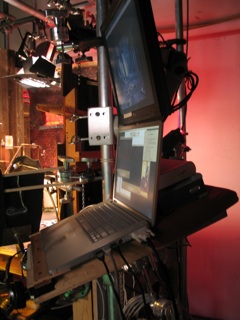
Attached to the set, there is a Mac PowerBook G4 laptop, and above it a small flat screen monitor. A little black-and-white spy cam is attached to the camera's viewfinder -- this sends a live feed to the monitor. Misha's been using FrameThief for his framegrabbing software.
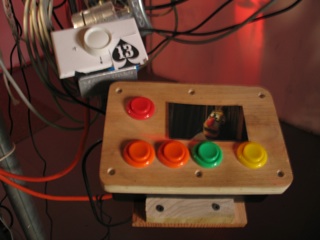
Beneath the laptop computer, there's a custom-made USB control box for toggling between frames. Credit goes to Kelly Mazurowski for the invention. [Also note the dimmer for adjusting the lights each frame -- to simulate a flashing neon sign.]
Mostly the film has been shot on 1s. But, to my great surprise, Misha said that he'd been getting into shooting at 18FPS recently. Partly this was to make some progress in time for the party… But beyond that, he says it has a really nice feel. He described 12FPS as being too little -- 24FPS as being "unforgiving" of any errors in your arcs -- and 15FPS being pretty nice… 18 is forgiving and more "gestural."
My understanding is that after the footage is shot, he'll let the computer stretch 18FPS out to 24FPS for him.
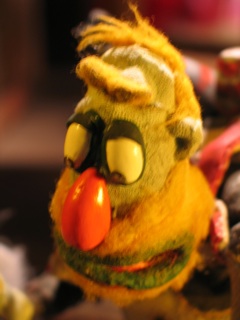
The Fred puppet was constructed using the build-up method on top of a recycled B&S armature. He's meant to look rough-hewn and handmade. The eyes are coated with enamel paint; the pupils are bits of clay attached with sticky wax.
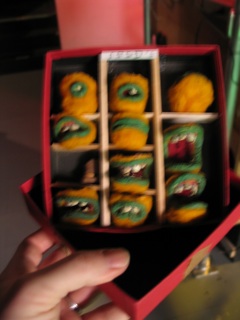
Fred has replacement mouths that click into place with magnets. However, the wide mouths also have wire in them, so they are somewhat posable. Seam lines are hidden by the beard.
…This is the first time I've seen hybrid replacement mouths like this.
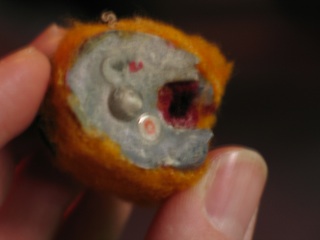
To maintain the continuity of Fred's teeth between shots, the upper and lower jaws were made using fast-cast plastic. The top jaw has two tiny inset magnets, and a hemispherical bump to key the part into place. There's a square hole so a tongue can plug into the puppet's skull for certain shots.
Misha confirmed something I'd been wondering about… That when you use magnets for registration, it's important to get the magnets lined up so that their polarities don't compete.
Gotta say: I'm hugely impressed by this mouth system!
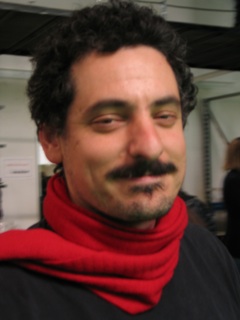
Big thanks to Misha for sharing details about this project!
The clips I've seen -- both for Misha's film and for Owl Pals -- are simply stunning… If you're anywhere near Portland, I highly recommend turning out for Wednesday's "Clowns & Owls" event!
posted by sven | May 11, 2009 7:00 AM | categories: exhibits & events, stopmo